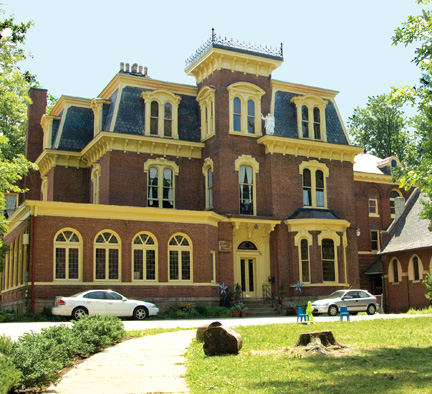Hands-on History
Bloomfield mansion serves as lab for Pitt’s new architectural research classes

Brendan Froeschl remembers being amazed when he first set foot in the Waldorf School of Pittsburgh, housed in a stately post-Civil War mansion in Bloomfield.
Froeschl is the school’s building manager and an alumnus of Belmont Technical College in Ohio, a nationally renowned school for building-preservation technology. He recognized a treasure when he saw it. The Waldorf School is an independent, not-for-profit school with an arts-based curriculum for children in preschool through fifth grade.
“This place just has to be a laboratory for some sort of architectural research,” Froeschl remembers thinking as he gazed at the mansion’s 14-foot high tin ceilings, carved corbels, stained-glass windows, moldings, and etched glass panels on the front doors.
Propelled by his impressions, Froeschl contacted Drew Armstrong, director of Pitt’s Architectural Studies Program, and expressed interest in pursuing a partnership with Pitt. The result: two course offerings where Pitt students use the Waldorf School as a hands-on classroom, with the promise of more courses to come.

Drew Armstrong
This past summer, Froeschl used the school to teach a three-credit class on window restoration. It allowed students to document the condition of some of the mansion’s 130 windows—to remove them, learn how to restore them, and understand how restoration functions in a building.
Art of Historic Documentation
In the second course, Pitt Instructor Jeff Slack, a historic preservation specialist at Pfaffmann + Associates PC, Downtown, had the students trace the architectural history of the 21-room house at 201 S. Winebiddle St., built for Henry J. Lynch around 1867. While currently housing the Waldorf School, the building also has been known as Victoria Hall, a venue for weddings and parties (1993-2001), and the Ursuline Academy for Young Women, (1895-1993), an exclusive college preparatory school administered by the Ursuline Sisters.

Jeff Slack
Slack’s students pored over old documents and photos, conducted deed searches at the Allegheny County Real Estate Office, scrutinized old city maps, and reviewed census records. They heard from guest lecturers on masonry, wood, and methods for documenting old buildings. But, most importantly, they interacted with the building itself—studying its condition right down to the bricks and mortar, in an effort to determine whether the structure had been altered—and, if so, when and why.
After 11 weeks of carefully directed research, the students compiled their historical documentation findings into a substantial Historic Structure Report. Submitting the report is a step toward having the house ultimately placed on the National Register of Historic Places.
“It was rewarding to see young people so excited about old buildings,” said Slack, who has a master’s degree in historic preservation from Cornell University. “I enjoyed watching them make their discoveries.”
To give the students a taste of the real world of historic preservationists, Slack began each class with a project meeting to review progress and discuss the next steps. There were weekly assignments in addition to the task of drafting the final report. An old physics lab in Pitt’s Thaw Hall was converted into a studio, to place the students in the actual environment of an architect. According to Slack, these students now have skills they could use in the preservation of historic buildings.
More Courses Ahead
This delving into the past is actually propelling Pitt’s history of art and architecture department forward. The historic preservation and documentation course will be offered every summer, and two other six-credit architectural studio courses are on the schedule for the spring and fall terms. The hope is to have more students back at the Waldorf School in summer 2009, studying and documenting the carriage house, chapel, and auditorium.
Armstrong hopes to expand historic preservation as a component in the School of Arts and Sciences. This would help position Pitt undergraduate students for master’s degree programs in historic preservation. Indeed, a number of the students who graduated from the Architectural Studies Program this past year will continue their studies at the master’s level at Penn State, Cornell, and Columbia universities.
In fact, Pitt is laying the groundwork for what could be a Master of Historic Preservation program. According to Armstrong, he envisions a unique interdisciplinary degree program that would capitalize on the strengths of the University as well as the wealth of on-site study opportunities in Pittsburgh that could attract students from across the country.
“This is trailblazing—to offer these courses at the undergraduate level,” said Armstrong, referring to the new courses taught this past summer. He added that the window-restoration class is a model for future hands-on courses in materials conservation. It is his hope that similar joint ventures could be formed with other institutions.
Studying historic preservation seems a natural for students in Pittsburgh, with its real-life textbook of historic homes and churches, grand architecture, and three active preservation organizations, including the nationally renowned Pittsburgh History and Landmarks Foundation.
Keeping Site Memories Alive
“Sites are more than just property,” said Armstrong. “Since the late 1960s and early ’70s, we’ve had an awareness that a building needs to be thought about in a more complex way. Documentation is a big part of that. Without it, the significance of the building disappears.” Documentation keeps the memory of a site alive, according to Armstrong, and provides information to the public and scholars.
“It’s the real cornerstone of proper preservation,” he said. “It helps us understand what to preserve and why.”
On July 31, the nine students taking the course presented their findings to a group of about 50 Bloomfield residents, preservationists, and reporters. They discovered that Lynch, a dry goods merchant with a business Downtown, had paid $11,150 in 1865 to buy seven acres of land at the Waldorf School site from Harriet Winebiddle. In 1872, after the Second Empire-style mansion had been built, Lynch sold the mansion along with one acre to William Smith for $22,500. The property would eventually change hands eight more times.
The student team had researched each architect of the home’s separate additions, and they revealed the possibility that the unknown architect of the main house may have been Isaac Hobbs, architect of the Dollar Savings Bank on Fourth Avenue, Downtown. The students’ research showed that Hobbs and Lynch worked closely together when Lynch sat on the bank’s board of directors, from 1864 to 1906.
Pitt student Denise Duryea said finding long-lost information about the house and its owners was “very exciting.” The course was extremely informative and very effective at imparting a practical understanding of the field, said Duryea, who has applied to a number of Master of Architecture programs, with a focus on sustainable architecture and preservation.
“Jeff promised that by the end of the summer, we would be employable as preservation assistants,” she smiled. “And he delivered.”
Other Stories From This Issue
On the Freedom Road

Follow a group of Pitt students on the Returning to the Roots of Civil Rights bus tour, a nine-day, 2,300-mile journey crisscrossing five states.
Day 1: The Awakening
Day 2: Deep Impressions
Day 3: Music, Montgomery, and More
Day 4: Looking Back, Looking Forward
Day 5: Learning to Remember
Day 6: The Mountaintop
Day 7: Slavery and Beyond
Day 8: Lessons to Bring Home
Day 9: Final Lessons

